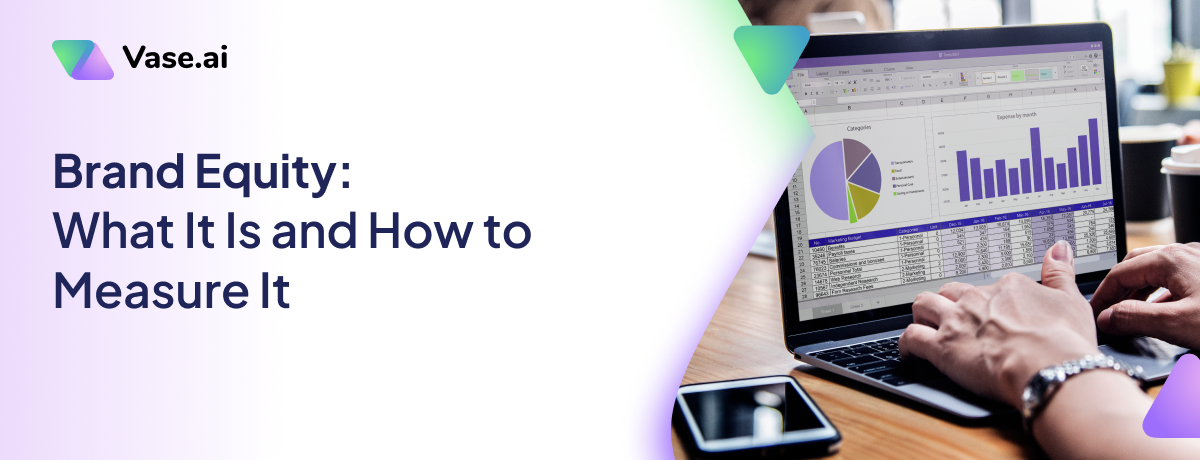You’ve probably heard the term “brand equity” thrown around in business meetings, marketing blogs, or in casual conversations with entrepreneurs. But what does it actually mean? And more importantly, why should you care about it?
Here’s the deal: brand equity is the secret sauce that makes customers choose your product over a competitor’s, even if yours costs more. It’s the reason people line up for hours to buy the latest iPhone, even though there are cheaper alternatives. It’s why you’ll pay $5 for a Starbucks latte when you could make coffee at home for pennies.
Brand equity isn’t just about having a recognizable logo or a catchy slogan. It’s about the value your brand holds in the minds of your customers. It’s the emotional connection, the trust, and the loyalty that keeps them coming back for more.
So, if you’re running a business, whether a startup or an established company, you need to understand brand equity. Because without it, you’re just another option in a sea of competitors. And let’s be honest, no one wants to be just another option.
Here's What We'll Cover:
- The Effect of Brand Equity on Consumer Purchase Habits
- The Two Sides of Brand Equity: Economical and Emotional
- 7 Ways to Measure Brand Equity
- Bringing It All Together: Building and Maintaining Strong Brand Equity
- FAQs About Brand Equity
- Final Thoughts
The Effect of Brand Equity on Consumer Purchase Habits
Think about the last time you bought something. Did you go for the cheapest option, or did you choose a brand you know and trust? Chances are, you went with a familiar brand –ºnot because you’re loyal—but because that brand has equity.

Brand equity provides a competitive edge. It sets you apart in a crowded marketplace. When you have strong brand equity, customers are more likely to choose your product, even if it’s more expensive. They’re also more likely to stick with you in the long run, which means repeat business and increased revenue.
But here’s the thing—building brand equity isn’t easy. It takes time, effort, and a whole lot of strategy. And once you’ve built it, you need to measure it. Because what gets measured, gets managed (quoting Peter Drucker here!)
The Two Sides of Brand Equity: Economical and Emotional
There are two main approaches to measuring brand equity: economical (O data) and emotional (X data). Let’s break these down.
Economical (O Data)
This is all about the numbers. We’re talking sales data, financial reports, and HR metrics – quantifiable data you can measure over and over again. But while it’s great for showing you what’s happened in the past, it doesn’t tell you much about the future.
Let’s say sales have been skyrocketing for the past six months. That’s awesome, but it doesn’t explain why. Are customers buying because they love your brand, or because you had a killer promotion? Without understanding the “why,” it’s hard to predict what’s going to happen next.
Emotional (X Data)
This is where things get interesting. Emotional data is all about the qualitative reasons behind customer decisions. It’s about how your brand “sits” in people’s minds and the emotional connections they have with it.
When someone buys a product from your brand, they’re not just buying the product itself. They’re buying the values and identity your brand represents. Maybe your brand makes them feel successful, or maybe it aligns with their self-image. Either way, it’s this emotional connection that drives loyalty and repeat business.
You need to measure both numbers and emotions to measure brand equity accurately. Together, they give you a full picture.
7 Ways to Measure Brand Equity
Here are seven ways to measure brand equity, complete with examples of metrics you can use to collect.
1. Brand Evaluation
At Vase.ai, we help our clients measure the total value of their brand as a standalone monetary asset. This is something that can even be reflected on their balance sheet. Brand evaluation isn’t just about what you’ve spent; it’s about understanding the full financial impact your brand has on your business.
We guide you through this process by focusing on three key factors: cost-value, market-value, and income-value. Here’s how we do it:
Cost-Value: What You’ve Spent
We help you calculate the money you’ve invested in building your brand—from ads and trademarks to logos and campaigns. If you’ve spent $1 million on branding, that’s your cost-value. We make sure you have a clear record of every dollar invested, so you know exactly what it took to create your brand.
Market-Value: What It Could Sell For
We assist you in estimating your brand’s market-value by analyzing what similar brands in your industry are worth. For example, if a competitor’s brand sold for $5 million, we use that as a benchmark to help you understand your brand’s potential market value.
Income-Value: What It’s Earning
This is where we shine. We help you measure the revenue your brand generates or the money it saves your business. If your brand has driven $10 million in sales over the past year, that’s your income-value. We provide the tools to track and analyze this data, proving that your brand isn’t just a logo—it’s a revenue driver.
2. Brand Awareness
Brand awareness is all about one thing: how well people know your brand. It’s not just about recognition—it’s about how your target audience, the market, and key stakeholders feel about your brand. Are you a household name, or are you still flying under the radar?
Let’s say you run a focus group and discover that 90% of participants know your brand. That’s awesome! But if only 50% have actually bought from you, there’s a gap. People know you—they just aren’t convinced yet. That’s your cue to work on building trust and turning awareness into action.
Here’s how to measure and boost your brand awareness:
Ask the Right Questions
Start by talking to your customers. Find out:
- Do they know your brand exists?
- Would they consider buying from you in the future?
- Have they bought from you before?
These answers reveal how well your brand is sticking in their minds.
Listen to the Buzz
How much are people talking about your brand? This is your “conversation share.” Are you a hot topic in everyday chats, or are you being drowned out by competitors? Social media mentions, reviews, and even casual conversations can give you clues.
Focus Groups
Get real-time feedback from your target audience. For example, at Vase.ai, we connect you with a diverse panel of over 3.6 million Southeast Asian consumers. This allows for in-depth discussions and real-time feedback from your target audience.
Research Panels
We allow you to access a broad spectrum of consumers to gain insights into brand perception. This helps you understand how your brand is viewed in the market.
Social Media & Reviews
Track what people are saying about you online. For instance, at Vase.ai, we offer tools to monitor social media mentions and analyze sentiment. This allows you to understand public opinion and online discussions about your brand.
Website Searches
Check how often people are looking you up. In other words, monitor increases in organic search traffic over time. You can do this by integrating Vase.ai's insights with tools like Google Analytics.
3. Brand Strength
Brand strength is all about the emotional data. It’s the special place your brand holds in someone’s mind after they’ve interacted with it over time. In other words, it’s about how much people “want” your brand.
So, how do you measure this elusive “want factor”? Here’s the lowdown:
Ask Your Customers
The easiest way to gauge brand strength is by asking your audience directly. Use surveys to dig into their preferences. For example:
- How likely are you to choose us over a competitor?
- Do our values resonate with you?
These questions reveal how much your brand stands out in their hearts and minds.
Use Proven Models
If you want to get fancy, there are tools and frameworks designed to measure brand strength. Some popular ones include:
- Millward Brown’s MDF Framework: Helps you understand how your brand performs in the market.
- Ipsos’ Brand Value Creator (BVC): Focuses on the emotional and functional value your brand delivers.
- TNS’ Conversion Model (CM): Tracks how likely customers are to stick with or switch from your brand.
These models give you a clearer picture of how your brand stacks up against competitors.
Look at the Numbers
Let’s say you run a survey and find that 80% of customers prefer your brand over a rival. That’s a great sign! But don’t stop there. Check your Net Promoter Score (NPS)—a metric that shows how likely customers are to recommend your brand. If your NPS is low, it might mean people like your brand but aren’t passionate enough to shout about it. And that’s a gap worth fixing.
Here’s an example of how we calculate NPS at Vase.ai:
Question:
- "On a scale of 0 to 10, how likely are you to recommend [Brand/Product/Service] to a friend or colleague?"
Follow-up Questions (Optional):
- "What is the primary reason for your score?"
- "What can we do to improve your experience?"
Results Dashboard:
- NPS Score: 60
- Promoters: 70%
- Passives: 20%
- Detractors: 10%
Having a high NPS means you have loyal customers, higher sales, and a competitive edge.
4. Brand Relevance
Brand relevance isn’t just about making customers happy. It’s about proving your brand delivers unique value that matters to them.
At Vase.ai, we help our clients prove that their brand delivers unique value. We do this by making it not just another option, but the one their customers can’t live without. For us, brand relevance is about creating a deep, emotional connection that drives loyalty and advocacy.
Here’s how we help you measure and improve your brand relevance:
Measure Satisfaction (But Don’t Stop There)
We start by helping you gauge customer happiness through Customer Satisfaction (CSAT) Surveys. For example, if 90% of your customers say they’re satisfied, that’s a great start. But we know satisfaction alone isn’t enough to keep them loyal. That’s why we go deeper.
Check Emotional Connection with NPS
We use Net Promoter Score (NPS) to measure how emotionally connected your customers are to your brand. A low NPS might mean customers like you but aren’t passionate enough to recommend you. A high NPS, on the other hand, shows your brand is not just relevant—it’s irreplaceable. We help you track and improve your NPS to turn satisfied customers into loyal advocates.
Dig Deeper with Conjoint Analysis
We take it a step further with conjoint analysis, a powerful tool that reveals which features of your brand customers value most. Is it your price, quality, or customer service? We help you identify what makes your brand stand out—and what might be falling flat.
For example, if your CSAT is high but your NPS is low, it means customers are happy but not loyal. We help you bridge that gap by uncovering the emotional drivers that will turn satisfaction into passion.
5. Output Metrics
At Vase.ai, we help our clients measure the ROI of their brand efforts through comprehensive output metrics.
For example, if you send out 10,000 emails promoting a new product, we help you measure how many clicks and purchases result from that effort. A 10% conversion rate? That’s a clear output metric showing your campaign’s success. But we don’t stop there—we also analyze sales transactions, pricing power, and customer responses to CTAs (like signing up for a loyalty program). These insights help you understand whether your efforts are driving real value.
With Vase.ai, you can track and improve every aspect of your output metrics. The aim is to ensure your brand communications deliver measurable results.
6. Financial Data
At Vase.ai, we understand that financial data is critical to measuring brand equity. That’s why we enable our clients to track key financial metrics. These include profitability, revenue growth, and customer acquisition costs.
For instance, if your revenue is growing at 10% annually, that’s a strong indicator of healthy brand equity. But what if your customer acquisition costs are also rising? We help you spot these trends early, so you can adjust your strategies before they impact your bottom line.
We integrate your financial data into your brand analysis. This empowers you to make smarter investments in branding and marketing.
7. Competitive Metrics
At Vase.ai, we specialize in helping brands understand how they stack up against competitors. We calculate competitive metrics like acquisition rates, market dominance, and channel-specific revenue. With this data, we then provide actionable insights to strengthen your market position.
Let’s say a competitor’s marketing campaign is driving traffic to their website and your acquisition rates are dropping. We will help you identify the impact on your brand equity.
Last year, we conducted a competitive analysis for a vegan skincare brand. The brand was targeting eco-conscious millennials. The insights revealed that they had strong brand awareness. But one of their competitors had stronger consumer loyalty. Our research showed that there were two main reasons for this. One was their zero-waste packaging and the other was higher NPS. Armed with this data, we advised our client to launch recyclable packaging. We also advised them to expand their product line, which they did. Within 6 months, our client was able to improve their NPS from 40 to 55.
By understanding what’s working (and what’s not) for your competitors, you can make more informed decisions about your own brand strategy. With Vase.ai, you don’t just track your performance. You also gain the insights needed to outrank the competition.

Bringing It All Together: Building and Maintaining Strong Brand Equity
Brand equity isn’t something you can set and forget. It’s not a one-time project or a quick fix. It’s an ongoing process that requires constant attention and effort. But if you do it right, the rewards can be huge.
So, let’s dive into some practical tips and strategies for building and maintaining strong brand equity.
1. Consistency Is Key
One of the most important things you can do to build strong brand equity is to be consistent. Consistency in your messaging, your visuals, and your customer experience is what helps build trust and recognition over time.
Think about some of the most successful brands out there—Apple, Nike, Coca-Cola. What do they all have in common? Consistency. Their logos, their messaging, their customer experience—it’s all consistent across every touchpoint.
So, if you want to build strong brand equity, start by making sure your brand is consistent. Use the same colors, fonts, and tone of voice in all your communications. Make sure your customer experience is consistent across every channel. And most importantly, stay true to your brand values.
2. Focus on Customer Experience
Your brand is only as strong as the experience you deliver to your customers. If your customers have a positive experience with your brand, they’re more likely to come back and recommend you to others. If they have a negative experience, they’re more likely to switch to a competitor.
So, focus on delivering a great customer experience at every touchpoint. This includes everything from your website and social media channels to your customer service and product quality.
For example, let’s say you run an e-commerce store. Make sure your website is easy to navigate, your checkout process is smooth, and your customer service is responsive. If a customer has a problem, resolve it quickly and professionally. These small things can make a big difference in how your brand is perceived.
3. Build Emotional Connections
As we’ve discussed earlier, emotional connections are a key part of brand equity. When customers feel emotionally connected to your brand, they’re more likely to choose you over a competitor, even if you’re more expensive.
So, how do you build emotional connections? Start by understanding your customers’ needs, desires, and pain points. What are they looking for in a brand? What values do they care about? How can your brand help them achieve their goals or solve their problems?
Once you understand your customers, you can start to build emotional connections by aligning your brand with their values and aspirations. For example, if your customers value sustainability, make sure your brand is committed to eco-friendly practices. If they value innovation, highlight the cutting-edge features of your products.
4. Invest in Brand Awareness
Brand awareness is a key component of brand equity. If people don’t know about your brand, they can’t choose it over a competitor. So, invest in building brand awareness through marketing, advertising, and public relations.
But don’t just focus on quantity—focus on quality. It’s not enough to just get your brand in front of as many people as possible. You need to make sure your brand is being seen by the right people—your target audience.
For example, if you’re targeting millennials, focus on social media platforms like Instagram and TikTok. If you’re targeting professionals, focus on LinkedIn. And make sure your messaging is tailored to the platform and the audience.
5. Monitor and Adapt
Finally, remember that brand equity is not static. It can change over time based on market trends, customer preferences, and competitive activity. So, it’s important to monitor your brand equity regularly and adapt your strategy as needed.
Use the seven methods we’ve discussed to measure your brand equity on an ongoing basis. Keep an eye on your financial data, customer feedback, and competitive metrics. And be prepared to make changes to your strategy if you see a decline in any of these areas.
For example, if you notice that your brand awareness is declining, it might be time to ramp up your marketing efforts. If your customer satisfaction scores are dropping, it might be time to revisit your customer experience. The key is to stay proactive and responsive.
FAQs About Brand Equity
Alright, let’s wrap this up with some frequently asked questions about brand equity. These are the kinds of questions that might be on your mind as you think about building and measuring your own brand equity.
1. What’s the difference between brand equity and brand value?
Brand equity and brand value are often used interchangeably, but they’re not the same thing. Brand equity refers to the added value a company has when they have a strong and positive brand name and public perception. Brand value, on the other hand, is the financial worth of the brand as a separate asset.
2. How long does it take to build brand equity?
Building brand equity takes time—there’s no quick fix. It can take years of consistent effort and investment to build strong brand equity. But the good news is, once you’ve built it, it can provide long-term benefits for your business.
3. Can small businesses build brand equity?
Absolutely! Brand equity isn’t just for big corporations. Small businesses can build strong brand equity by focusing on consistency, customer experience, and emotional connections. In fact, small businesses often have an advantage because they can be more nimble and responsive to customer needs.
4. How do I measure brand equity if I’m just starting out?
If you’re just starting out, you might not have a lot of data to work with. But you can still measure brand equity by focusing on brand awareness and customer feedback. Use surveys, focus groups, and social media to gather insights about how people perceive your brand.
5. What’s the role of social media in brand equity?
Social media plays a huge role in building and maintaining brand equity. It’s a powerful tool for increasing brand awareness, engaging with customers, and building emotional connections. But it’s important to use social media strategically—focus on the platforms where your target audience is most active.
6. How do I know if my brand equity is strong?
You can gauge the strength of your brand equity by looking at metrics like customer loyalty, brand awareness, and financial performance. If customers are choosing your brand over competitors, recommending you to others, and willing to pay a premium for your products, that’s a good sign that your brand equity is strong.
7. Can brand equity decline?
Yes, brand equity can decline if you don’t maintain it. Factors like poor customer experience, negative publicity, or increased competition can all lead to a decline in brand equity. That’s why it’s important to monitor your brand equity regularly and make adjustments as needed.
8. How do I rebuild brand equity if has declined?
Rebuilding brand equity takes time and effort, but it’s possible. Start by identifying the factors that led to the decline—whether it’s poor customer experience, negative publicity, or something else. Then, take steps to address those issues and rebuild trust with your customers. This might involve improving your product quality, ramping up your marketing efforts, or launching a new campaign to reposition your brand.
Final Thoughts
Brand equity is one of the most valuable assets a business can have. It’s what sets you apart from the competition, drives customer loyalty, and ultimately, boosts your bottom line. But building and maintaining strong brand equity isn’t easy—it takes time, effort, and a whole lot of strategy.
Critically, brand equity isn’t static. It evolves with market trends, customer preferences, and competitive dynamics. That’s why constantly measuring and monitoring your brand equity is essential.
That’s why at Vase.ai, we provide regular insights into how your brand is perceived, where it stands against competitors, and what drives customer loyalty. This data allows you to adapt quickly, address gaps, and stay ahead.
Ready to take control of your brand equity?









![How to Conduct Competitive Analysis [With Templates]](https://www.vase.ai/hubfs/How%20to%20Conduct%20Competitive%20Analysis/CompetitiveAnalysis_HeroBanner.png)